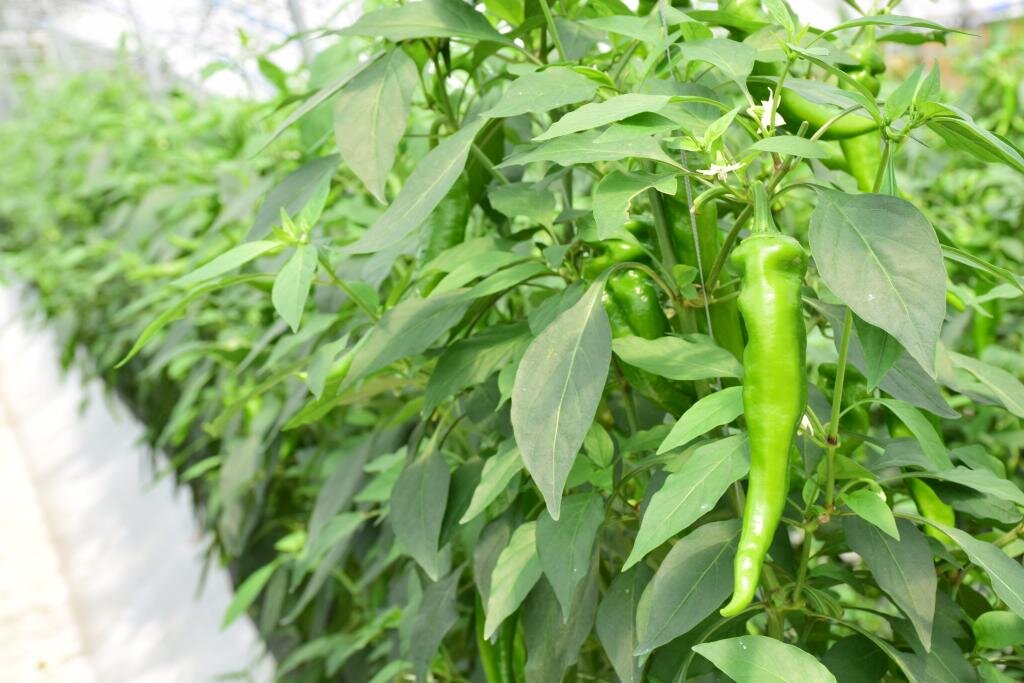King Manganji
town and culture 9.1.2021
It’s the height of summer and one of Kyoto by the Sea’s vegetables is thriving in the strong sunshine, the Manganji Amato. At first sight, it looks like an especially large hot pepper, but it’s actually sweet. This pepper takes summer cuisine to the next level because it taste great cooked a variety of ways, whether that be grilling, baking, or frying. Get ready to learn more than you ever thought you would about the Manganji Amato, the King of Peppers.
| Grown here in Ayabe, Fukuchiyama, and Maizuru
First, let’s get something I know you’ve been wondering out of the way, the Manganji Amato, grown only in this area, is not the same as the Manganji Togarashi grown throughout other areas in Japan. Were you wondering about that? It might be worth noting that the word ‘Amato’ has the connotation of being sweet, while ‘togarashi’ refers to peppers with capsicum (spice, think chili peppers).
inspection before preparing to ship
The growers here are fanatical about quality control, and there are regulations regarding the varieties and cultivation methods, some of which deal with the sizes and shape of the harvested peppers. For example, “excellent” peppers have good color gloss, a slight curve to the shape, and are between 13 and 23 centimeters. “Good” peppers, the next step down, are at least 10 centimeters long. At the pepper inspection areas, workers will select only the peppers that meet all of these standards to be official “Manganji Amato” brand peppers. I suppose the other peppers will have to try again next year.
These standards aren’t just for show though, "Manganji Amato" peppers are larger and thicker than other peppers. But surprisingly, there aren’t many seeds inside, and the flavor is slightly sweet. Children in Japan notoriously avoid peppers, but this one might even get them to eat their greens.
As mentioned above, the peak for this king pepper is summer, and the pepper ships nationwide between May and November. For those who fear they’ll miss out on the pepper mania, fear not. These peppers can be found in major cities like Osaka, Tokyo, and even south in Fukuoka. No wonder these peppers accounted for 400 million yen in sales in 2020.
|100 years and growing
The Manganji Amato, as one might expect from the king of peppers, has a 100-year royal lineage.
Around 1920, the "Manganji sweet pepper" was born in the Manganji district of Maizuru city. It is believed that the Fushimi hot pepper, which has been cultivated for a long time, was accidentally crossed with another variety, making it a native species to the Manganji district. Local agricultural cooperatives eventually effectively branded the pepper, but it was first cultivated just for personal consumption in the community.
In 1983, the name "Manganji Togarashi" was changed to "Manganji Amato". This would give consumers an indication that the peppers aren’t spicy. Growers in the area set up the Manganji Amato Subcommittee to set brand standards and start a full-scale shipping business. Sales increased dramatically and production expanded throughout Maizuru City in 1987. Then, in 1989, it was certified as the first "Kyoto brand product" by the Kyoto Hometown Products Association.
After the birth of JA Kyoto Ninokuni (an agricultural cooperative), established thanks to the merger of nine agricultural cooperatives in Maizuru City and the surrounding areas, production expanded to Ayabe City and Fukuchiyama City. This was in 2004, and Manganji Amato Subcommittees were established in these areas as well.
The species has been further refined with time and cultivation areas have expanded as well. Manganji is a sweet-tasting pepper, but in the past some of the harvested peppers were still very spicy. In 2007, the "Kyoto Manganji No. 1" was a brand-registered pepper, that through successful breeding managed to greatly suppress the spiciness. Then in 2021, the "Kyoto Manganji No. 2" was the result of breeders successfully suppressing spiciness. From this, it has evolved into the current Manganji Amato pepper.
In 2017, the "Manganji Amato" was registered as a GI (Geographical Indication) product for the first time in Kyoto Prefecture. GI refers to products that have been cultivated in a region, and are of high-quality in regards to things like climate and soil, and are registered and protected by the national government as intellectual property. In other words, this pepper was recognized nationally.
|320 producers in 3 cities
Currently, the cultivation area of "Manganji Amato" is fifteen hectares across three cities (Maizuru, Ayabe, Fukuchiyama). There are about 320 producers, and we had the chance to speak with one of them.
Kitayama-san harvesting
We visited Kitayama Farm in Nakade, Miwa-cho, Fukuchiyama City. The grower, Keisei Kitayama, is from Fukuoka prefecture and started producing Manganji Amato peppers in 2012 after moving to the area. He is the chairman of the "Fukuchiyama Manganji Amato Subcommittee". The following is our interview with him.
-What made you start cultivating the Manganji Amato?
"For those new to working in agriculture it’s necessary to choose between mizuna or the Mangaji Amato, and with a small initial investment we selected the Manganji Amato."
-Could you share both some difficulties and ingenuity required for growing?
"The Manganji Amato is an F1 hybrid variety of pepper, but not an easy one to produce. It’s a native variety that is easily affected by the environment and has a low yield, so if you want to improve the quality and yield of this F1 variety, it takes twice as much time and effort. We spend a lot of effort and time in devising ways to determine the amount and frequency of watering, as well as the best way to go about pepper harvesting in order to maintain the appropriate volume of peppers on the plant."
-What are the key characteristics of "Manganji Amato"?
"It’s the only variety in the "Manganji Togarashi "genre that does not yield solely spicy peppers. Chefs and parents of small children can rest assured that these peppers can be served to anyone regardless of whether they can handle spicy food. That is the key feature of Manganji Amato. "
-What are your future goals?
"Manganji Amato are now well known, but this is the result of previous growers building a solid brand. I’m just benefitting from it. Current growers can simply reap the benefits of the Manganji Amato brand for themselves, or create and leave something for the next generation of growers. It really depends on what we choose to do. There are so many people in today’s world who live for just the present, or just for money, or just for themselves. We hope to continue carrying on the brand that was built for us in order to create an even stronger brand for the next generation of Manganji Amato growers. I see it as an obligation, and I hope to attract more food lovers to this delicious pepper for the sake of our future growers.
packaged Manganji Amato
Manganji Amato is sold at all Saisaikan marketplaces. Saisaikan is JA Kyoto Ninokuni's direct sales shop for agricultural products. It is also sold at food supermarkets. For the best ways to prepare the Manganji Amato, there is an Amato Club, consisting of 62 people from the food service and food processing industries in this area, where each member creates recipes and foodstuffs using Manganji Amato peppers.
If you’ve read this far, you’ve got to at least try one of these peppers. We’ve included a couple of recipes to whet your pepper appetite.
RECIPE
"Manganji Amato" is amazingly versitile, whether eaten as is, fried, or served in soy sauce and salt. We are going to introduce a couple of the recipes created by the Kyoto Furusato Products Association.
* Both photos and recipes were provided by the Kyoto Hometown Products Association.
Deep-fried pepper with minced meat
Ingredients (serves two)
・6 whole Manganji Amato peppers
・150 grams of minced meat
・100 grams of cabbage
・2 Tomatoes
・100 grams of onion
・1 egg (scrambled)
・200ml of bread crumbs
・30ml of flour
・salt (as needed)
・ Sauce 1: 20ml tomato ketchup, 20ml Worcestershire sauce, 10ml mayonnaise
・ 10ml salad oil
・ Frying oil (as needed)
[directions]
(1) Cut Manganji sweet peppers vertically and remove the seeds. Cut cabbage into thin slices and cut tomatoes into easy-to-eat pieces.
(2) Peel and chop the onions, put the vegetable oil in a frying pan and fry, then season with salt and let cool.
(3) Put minced meat in a bowl, add 2 onions and half the amount of beaten egg. Mix well, add salt and season, and stuff mixture into one of the Manganji Amato peppers.
(4) Add flour, the remaining beaten egg, and bread crumbs to the other three peppers and fry in oil at about 160 degrees.
(5) Plate the peppers with a bowl of sliced cabbage and tomatoes and add the prepared sauce.
Kimpira
Ingredients (serves two)
・12 Manganji Amato peppers
・1 spicy pepper (chili pepper works well)
・ sauce: 40ml sake, 30ml soy sauce, 30ml sugar,
・10 ml salad oil
Directions
(1) Cut Manganji Amato peppers in half vertically, removing the seeds. Then cut into diagonal slices (keeping the peppers separate for measuring later - see below).
(2) Remove the seeds from the spicy pepper and cut into round slices.
(3) Heat the vegetable oil in a pan, add one Manganji Amato, and fry well over medium heat.
(4) Cook another three Manganji peppers with the sauce over a high heat. When cooked, add another two, mix them, and turn off the heat, then serve in a bowl.









